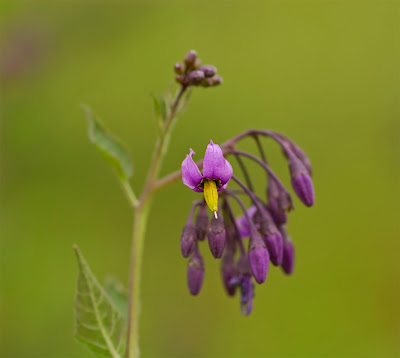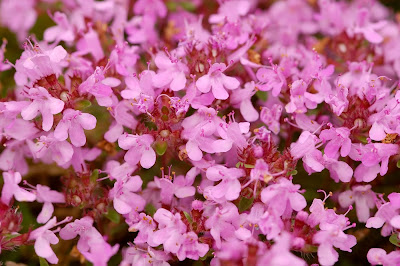The shore areas covered on this walk along the Clyde (from Cardross to Ardmore Point) form a part of 3 different designated protected sites: the Inner Clyde Site of Special Scientific Importance (SSSI), the Inner Clyde Ramsar Site and Inner Clyde Special Protection Area (SPA).
This section of the River Clyde shoreline is an SSSI because it contains saltmarsh (intertidal vegetation such as eelgrasses) and because it supports significant numbers of wintering birds, in particular: Eider, Cormorant, Goldeneye, Oystercatcher, Red-breasted Merganser, Red-throated Diver and Redshank.
Around 2100 Redshank feed here outside the breeding season (this being the reason for both SPA and Ramsar Site status).
Recent reports of Quail in central Scotland sparked predictions of a 'quail invasion' and tempted me to walk along these coastal arable fields, knowing I'd be lucky to even glimpse one.
 |
| Ardmore Point at low tide |
I got a train from Dalmuir to Cardross (£6.60 return) and followed the footpath along the water's edge to Ardmore Point. In Cardross bay at low tide, House Martins collected mud from the shore for nest-building.
Sea Aster (Aster tripolium) grows in large mauve-flowered clumps on the beach near Cardross saw mill.
The African savannah? Or Scotland on a sunny (!) day?
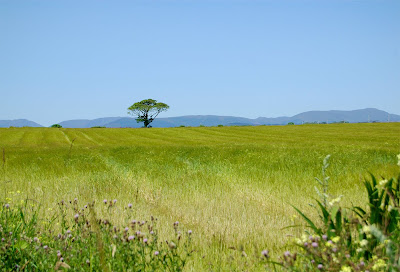 |
| Fields near Cardross |
 |
| Fields near Cardross |
A rich variety of wildflowers, encompassing every colour of the rainbow, flourish on the edge of the arable fields: some are coastal species, some are arable weeds and others, garden escapees or naturalized exotics.
 |
| Hedge Bindweed (Calystegia sepium) |
 |
| Hedge Bindweed (Calystegia sepium) unopened flower |
The delicate white, gramophone-esque flowers of Hedge Bindweed (Calystegia sepium) poked their trumpets through the bramble bushes. It actually belongs to the same family as Sweet Potatoe (Convolvulaceae) but is known to have purgative effects (hence, inedible).
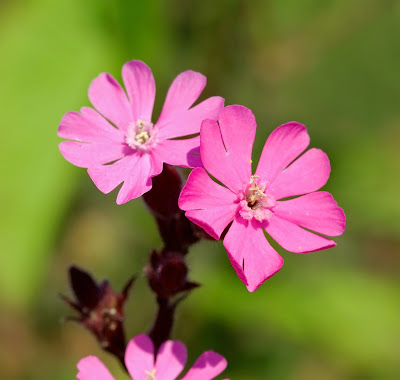 |
| Red Campion (Silene dioica) |
 |
| Canadian Goldenrod (Solidago canadensis) |
The two can be distinguished by their flower arrangement:-
- Canadian Goldenrod has smaller-petalled 'tufty' flowers which form a distinctly PYRAMIDAL pannicle (arrangement).
- Our native Goldenrod has loose, narrow pannicles of larger, fewer-petalled 'daisy-like' flowers.
 |
| Green Alkanet (Pentaglottis Sempervirens) |
Another non-native, Green Alkanet (Pentaglottis Sempervirens) is a strikingly beautiful plant nonetheless. As you might expect from the colour of its flowers, it's closely related to Borage and Forget-me-nots (Boraginaceae).
Its scientific name, a mix of Latin and Greek, means 'Five-tongued always-green' (Penta = five + glottis = tongue: from Greek glōtta, Attic form of Ionic glōssa, semper = always + virens = to be green/verdant: Latin).
 |
| Greater Sand Spurrey (Spergularia media) |
There are other very similar Spergularia species but Greater Sand Spurrey (Spergularia media) can be identified by these 3 key features:
1) Hairless.
2) Flowers have petals LONGER than sepals.
3) 10 stamens.
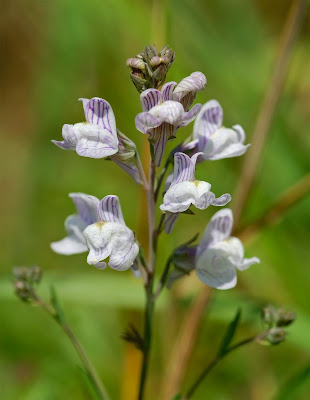 |
| Pale Toadflax (Linaria repens) |
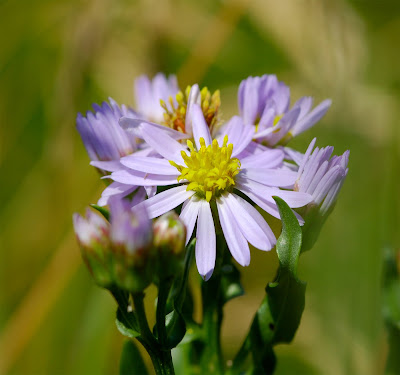 |
| Sea Aster (Aster tripolium) |
 |
| Sea Aster (Aster tripolium) |
Despite looking a lot like the common garden-escapee Michaelmas Daisy, Sea Aster is one of our 2 native Aster species. It's a saltmarsh and maritime specialist able to tolerate high salinities.
Sea Aster Recipes:
Buttered Sea Aster
Sea Aster Fish Bake
Sea Aster and Tomato Soup
Inland from Ardmore south bay (near Ardardan), I had excellent views of a singing Sedge Warbler. Also, flocks of Starling and House Sparrow. Ardmore north bay was filled with Curlew.
 |
| Aspen bark |
 |
| Mugwort (Artemisia vulgaris) |
Unlike most members of the daisy family (Asteraceae), it has wind-pollinated flowers.
Mugwort has been used for centuries worldwide in traditional herbal medicine, particularly for treating worms, menstrual cramps and digestive complaints. It was also used as a flavouring in beer (before hops) and food (especially in Asian cookery). Experiments show that it has insecticidal (mosquitoes and beetles) and antihelminthic properties.
Mugwort Recipes:
Mugwort Rice Cakes
Korean Injeolmi Rice Cakes
Note: It's very bitter-tasting and contains thujone (toxic in large doses) so consumption should be avoided by pregnant women.
 |
| Tansy (Tanacetum vulgare) |
 |
| Tansy (Tanacetum vulgare) |
Tansy is a petal-less member of the daisy family (Asteraceae), belonging to the same genus as Feverfew. In the past it was frequently cultivated as a medicinal herb and was valued as a treatment for worms and external parasites, for repelling insects, to control menstrual bleeding and to induce abortions.
Like Mugwort, Tansy has a strongly medicinal scent, is very bitter and contains thujole (pregnant women should avoid eating it).
Both the leaves and the button-like flowers yield a pale yellow dye when boiled.
Dyeing with Tansy:
http://ibrakeforyarnhooksandbooks.blogspot.com
http://www.allfiberarts.com (Showing the effects of alum, tin and rhubarb mordants).
http://thirtyeightstitches.blogspot.com (Showing the effects of copper, iron and alum/cream of tartar mordants).
 |
| Sweet Cicely (Myrrhis odorata) ripe seedpods |
- Strongly and sweetly scented.
- Leaves and stems covered in DOWNY HAIRS.
- White flowers.
- Whitish, splash-like markings at base of leaves.
- Seedpods = ridged, linear-oblong (canoe-shaped!), becoming shiny brown when ripe.
Sweet Cicely Recipes:
Rhubarb and Sweet Cicely Pudding (www.waldenlocalfood.co.uk)
Rhubarb and Sweet Cicely Pudding (www.telegraph.co.uk)
Sweet Cicely Custard (www.laetitiamaklouf.com)
 |
| Valerian (Valeriana officinalis) |
 |
| Valerian (Valeriana officinalis) |
 |
| Valerian (Valeriana officinalis) |
Well known for its powerful sedative effects, Valerian also contains the alkaloid actinidine; a powerful cat-attractant, and may provoke a response in cats unresponsive to catnip. More info can be found here.
 |
| Yarrow (Achillea millefolium) |
 |
| Yarrow (Achillea millefolium) |
Two species of crucifer were growing along the edge of the path: the white flowered Garden Radish and the lemon-yellow flowered Sea Radish.
 |
| Garden Radish (Raphanus sativus) |
 |
| Sea Radish (Raphanus raphanistrum maritimus) |
I *think* the Wild Radish pictured above is the subspecies maritimus, known as the Sea Radish, but I could be wrong. There's lots of variation within Raphanus and Wild Radish can have yellow, white or mauve flowers.
The most reliable way of separating them is to look at their seedpods:
- Consists of globular BEADS, EASILY BROKEN at joints and has long BEAKED tip = Wild Radish.
- Consists of globular BEADS, NOT EASILY BROKEN at joints and has long BEAKED tip = Sea Radish.
- UNBEADED = Garden Radish.
 |
| Dark Mullein (Verbascum nigrum) |
The densely packed, pale yellow flowers (with a slightly waxy appearance) and dark red, hairy stamens of Dark Mullein are very distinctive. It also lacks the coating of silvery hair found on most mulleins.
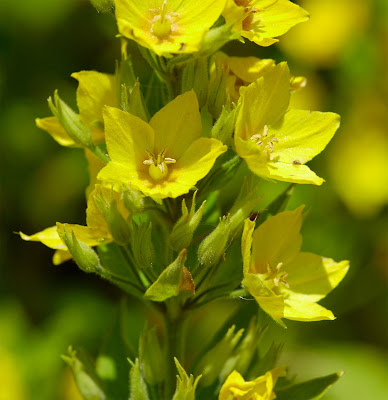 |
| Dotted Loosestrife (Lysimachia punctata) |
Dotted Loosestrife (Myrsinaceae family) is yet another non-native and despite its name, it's not closely related to our native Purple Loosestrife (Lythraceae family).
This plant doesn't produce nectar, instead the flowers produce fatty oils in order to attract specialist pollinators: Macropis sp. 'oil bees' (which are absent from Scotland).
 |
| Perennial Sow-thistle (Sonchus arvensis) |
 |
| Perennial Sow-thistle (Sonchus arvensis) |
Sow-thistles exude a milky white sap when damaged - much like Dandelion's.
Sow-thistle Recipes:
Sauteed Sow-thistles (from www.foragingfoodie.net)
Sauteed Sow-thistles (from weirdcombinations.com)
Sow-thistle Lasagne
Chinese Vinegar Peanut Salad (with Sow-thistles)
Stir-fried Sow-thistles and Pork
In terms of nutrition, Sow-thistles contain at least as much vitamin C per gram as oranges, have a high 'omega 3' fatty acid content and, like other leafy greens, are a rich source of minerals.
At this time of year the shore is quieter, though I did see a large (easily disturbed) flock of Oystercatchers and some Curlew.
 |
| Oystercatchers (below) and Starlings (above) |
I walked around Ardmore Point peninsula, where there are impenetrable thickets of hawthorn, golden-yellow gorse scrub and silvery-barked Aspens.
From the path, I saw a male Whitethroat singing prominently from a hawthorn - what a handsome bird! Warm sunlight caught the suffusion of pink on his breast and lent his white-rimmed eyes a reddish tint.
Common Blue butterflies were frequent on the upper shore (Ardmore Point).
On my return home I spotted a Turnstone and later, a Commic Tern*, both on the lower shore between Ardmore Point south bay and Cardross. There was also a flock of Goldfinches flitting about close to the path.
*Not a tern trying to be funny...birder-speak for those which can't be positively identified as either a Common Tern (Sterna hirudo) or an Arctic Tern (Sterna paradiseae).














